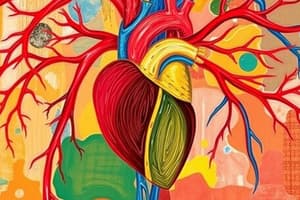Podcast
Questions and Answers
What is the circulatory system?
What is the circulatory system?
The circulatory system is the body system that transports blood and other materials.
How does the circulatory system help the cells?
How does the circulatory system help the cells?
It brings vital supplies to the cells and carries away their wastes.
What do the blood vessels of the circulatory system do?
What do the blood vessels of the circulatory system do?
They keep oxygen-poor blood from mixing with oxygen-rich blood.
What does the circulatory system do with oxygen?
What does the circulatory system do with oxygen?
What is the function of the circulatory system?
What is the function of the circulatory system?
What are the main parts of the circulatory system?
What are the main parts of the circulatory system?
What is the heart?
What is the heart?
Where does blood inside the circulatory system stay?
Where does blood inside the circulatory system stay?
What are the three types of blood vessels in the circulatory system?
What are the three types of blood vessels in the circulatory system?
What are arteries?
What are arteries?
What are veins?
What are veins?
What kind of blood do arteries carry?
What kind of blood do arteries carry?
What kind of blood do veins carry?
What kind of blood do veins carry?
How are arteries and veins connected?
How are arteries and veins connected?
What are capillaries?
What are capillaries?
What is the significance of the size of capillaries?
What is the significance of the size of capillaries?
Other than transporting vital supplies to cells, what does the circulatory system do?
Other than transporting vital supplies to cells, what does the circulatory system do?
What do your heart and blood vessels do when you're active?
What do your heart and blood vessels do when you're active?
What do your heart and blood vessels do in cold weather?
What do your heart and blood vessels do in cold weather?
Flashcards are hidden until you start studying
Study Notes
Overview of the Circulatory System
- Transports blood and vital materials throughout the body.
- Provides essential oxygen and nutrients to cells while removing waste materials.
Functionality
- Circulatory system maintains constant blood circulation to deliver oxygen and nutrients.
- Transports carbon dioxide from body cells to lungs for exhalation.
Components of the Circulatory System
- Main components include the heart, blood, and blood vessels.
- Blood vessels ensure oxygen-poor and oxygen-rich blood do not mix.
Blood Vessels
- Three types: arteries, veins, and capillaries.
- Arteries carry oxygen-rich blood away from the heart.
- Veins return oxygen-poor blood back to the heart.
- Capillaries connect arteries and veins, facilitating nutrient and gas exchange.
Heart
- A muscular pump about the size of a fist, essential for circulating blood.
Closed System
- Blood remains contained within vessels, signifying a closed circulatory system.
Capillaries
- Tiny vessels, one cell thick, crucial for efficient exchange; blood cells pass through in single file.
Waste Management
- Circulatory system collects metabolic waste and delivers it to the liver and kidneys for filtering.
- Aids in maintaining body temperature by distributing heat produced by organs and muscles.
Response to Activity and Temperature
- During activity, heart rate increases and blood vessels dilate to reduce heat.
- In cold conditions, blood vessels constrict to retain heat.
Studying That Suits You
Use AI to generate personalized quizzes and flashcards to suit your learning preferences.




